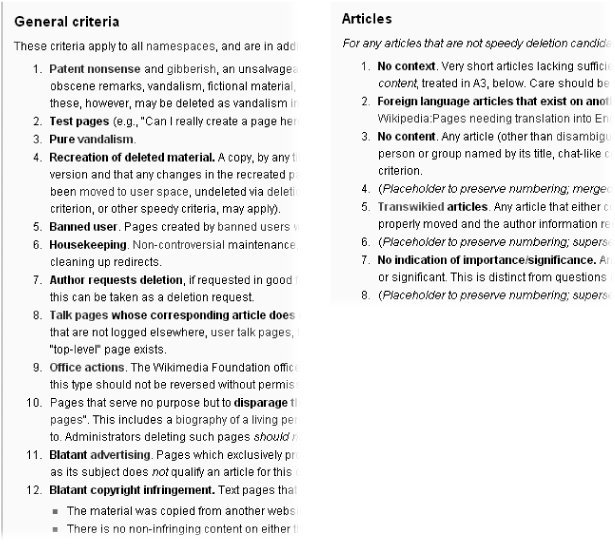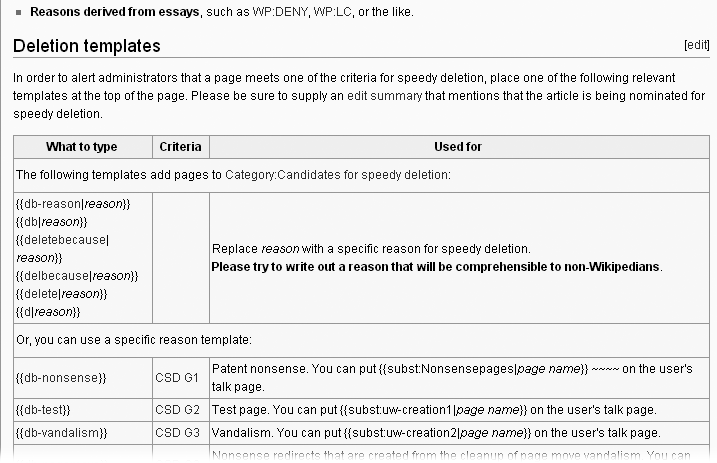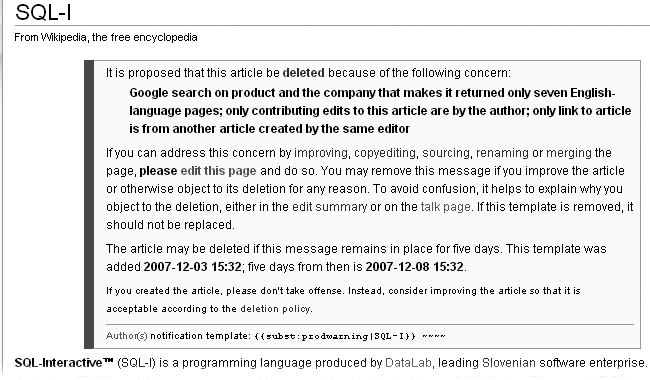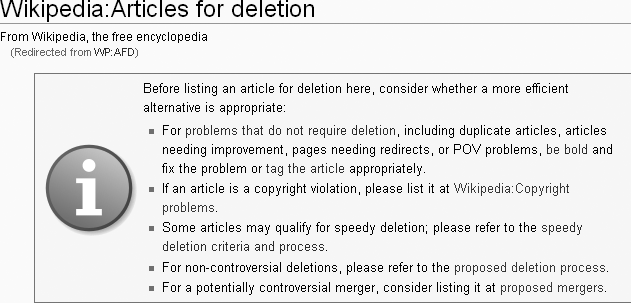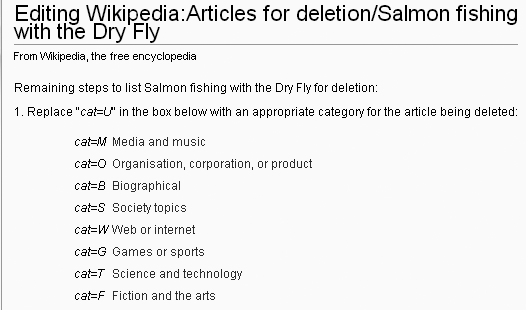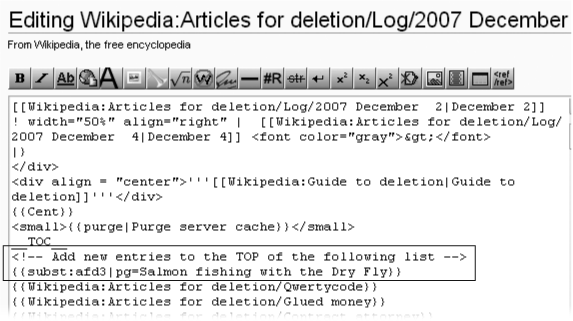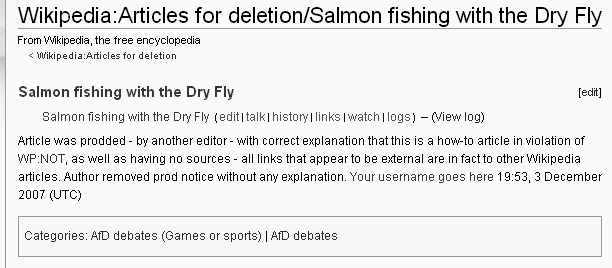Only administrators can delete articles outright. Your job is to ask for deletion using one of three methods:
Speedy. If the article meets any of the criteria in the Criteria for Speedy Deletion policy, then go for it.
Proposed deletion. If the article doesn’t quite qualify for a speedy deletion, then use the Proposed Deletion template, which starts a 5-day countdown.
Articles for Deletion (AfD). If you’re in doubt, start a discussion at the Articles for Deletion page about whether or not the article is worth keeping.
Each of the three methods follows a different procedure, discussed next.
Note
An article should have only one type of deletion being considered at any time: CSD, proposed deletion (prod), or AfD. If you see an AfD messagebox on an article, you should remove any CSD or prod templates on the same article; if you see a prod messagebox, you should remove any CSD template.
Figure 19-1. During 2006 and 2007, about half the articles that were created were subsequently deleted; an unknown number were also essentially deleted by being made into redirects. Between late 2006 and mid-2007, article deletions averaged about 2,000 per day. Since then, the trend has been downward, with the average in late 2007 being about 1,500 articles per day deleted. [This graph is from editor Dragons Flight (Robert A. Rohde), based on a log analysis he did in late 2007.]
Speedy deletions are based on specific criteria, listed in the policy Wikipedia:Criteria for speedy deletion (shortcut: WP:CSD). (See Figure 19-2.)
Figure 19-2. You can nominate an article for speedy deletion using criteria from either the general (“G”) list or the article (“A”) list. There are also separate lists, not shown, for redirects, images, media, categories, user pages, templates, and portals.
If you want to propose a speedy deletion for an article, you need to cite a specific criteria found on this page, either from the “G” (general) series (which applies to all types of pages, not just articles), or the “A” (article) series. For example, criteria G2 applies to test page (pages created by a new editor, just exploring possibilities).
You use the criteria to determine the template to post on the article; once you’ve done that, an admin shows up fairly quickly, reviews your nomination for deletion, and decides whether to remove the template (as an error) or accept it and delete the article. If you’ve made a particularly egregious error in placing the template on the page, you’ll also probably get a note to that effect from the admin.
Take, for example, an article called Sophie willis. The first step in any speedy deletion is to figure out whether an article in fact meets any specific CSD criteria. The entire article under consideration in this case reads “Sophie Ellen Willis. Born on 7th September 1992, in St. Albans.”
That looks like a vanity article (of sorts) about a teenager. If Wikipedia had an article for every person (ignoring the problem of reliable sources), there would be billions of articles, not 2.5 million or so.
This article looks like it fits CSD number A7, an article “that does not indicate why its subject is important or or significant”. (A7 also requires that the subject be a real person, organization, or web content, which is true here.) But before you pull the trigger and nominate the article for speedy deletion, you should check five other things:
The article talk page. In this case, the “discussion” tab is red, meaning that there is no article talk page. But if there was such a page, you’d want to see if there was any indication of notability there.
The article history page. First, check for vandalism – it’s embarrassing to nominate a page for deletion when in fact what you’re nominating is a perfectly good article that has just been vandalized. In this case, there were only two editors – the original one, who created the article, and an editor who added a “stub” template. If, on the other hand, there had been several editors adding content, that would indicate a speedy deletion might be inappropriate.
The What links here special page. Click the link in the left margin to see it. In this case, no other articles link to this article.
The User contributions page for the editor who created the article. I In this case, it shows only a single edit. So there isn’t any reason to assume that the author of the article understands (and is following) Wikipedia rules.
A Google or Yahoo or other search of the topic. In this case, a search of “Sophie Willis” produces a few results, but none that seem related to a person born in 1992.
So, from the review, it seems fair to say that this article looks like an A7.
Note
At this point, stop and consider if the solution to this problem article is to create a redirect, as discussed in “Alternatives to Deletion” on ???. Redirects are quicker, and don’t require an administrator. In this case, you’d redirect to the school district in which the elementary school is located. In this case, though, you can make a good argument for deleting the page altogether. That way, if the author creates it again, it shows up in the new page log, and gets more review than if an editor simply changes the redirect back to an article.
Once you’ve completed your initial review and found a criterion for deletion that fits, you can turn to the second step: actually nominating the article for deletion. Here’s the process:
Note
When the specific templates for a criterion don’t fit the situation exactly, use a general template.
You’ll find them at the top of the “Deletion templates” section, as shown in Figure 19-3. In most cases, a good template is {{delete|reason}}.
Figure 19-3. The list of deletion templates for speedy deletions starts with a number of general templates, which you can use for any of the specified reasons, or when you can’t figure out which one applies—but you’re sure that at least one does. Below the general templates are templates for each of the specific criteria.
Edit the article page, adding the template at the top of the edit box.
Paste it all the way at the very beginning of the wikitext, as shown in Figure 19-4.
Add an edit summary, being sure to mention both “speedy delete” and the specific CSD (in this case, “A7”). Preview the page, and then save it.
You see your request for deletion in a message box at the top of the article, as in Figure 19-5.
Figure 19-5. The message box that appears at the top of an article after you place a CSD template includes the reason for the proposed speedy deletion; information for other editors who might disagree with the nomination, including the editor who created the page; information for the administrator; and a suggestion to place a notice on the user talk page of the editor who created the article.
Post a notice on the user talk page of the editor who created the article.
Doing so isn’t just being nice (although it is nice). It also creates a record of the fact that this editor created this article. If the article does get deleted, the edit that created it will no longer be visible on the editor’s User contribution page, so this user talk page posting will be the only notice to other editors, useful if the pattern persists.
Once you complete these steps, you’re done for now. Check back in a day or so. What you do next depends on what’s happened to the article.
Most of the time the article’s gone, deleted by an admin.
If the admin reviewing the action rejected the nomination, then you usually want to move to the next step—deletion via proposed deletion (nicknamed prod), as discussed in the next section.
Maybe the reason for rejection is a persuasive argument against any type of deletion. If so, then it’s time to move on to something else. But usually rejection is because the admin decided that the CSD criterion really didn’t apply. That’s fine—there’s more than one way to get an article deleted.
If the editor who created the article deleted the CSD template (which is against the rules, but it happens), put it back up. You can just revert to your version. Also, post a warning on that editor’s talk page about violating the rules.
If another editor (besides the one who created the article) deleted the CSD template, look at the stated reason. Hopefully there’s one in the edit summary. Try to discuss the matter with that other editor, with the goal of arriving at consensus (you both agree whether the article should stay or go). Or try to get a commitment by the other editor to fix the article by a certain date, or let it get deleted.
If you can’t reach a consensus or find a way to fix the article, then go straight to the third type of deletion, an AfD (Articles for Deletion (AfD)).
Proposed deletion (shortcut: WP:PROD) is a way to nominate an article for deletion, used when you think the deletion won’t be controversial. If the deletion meets the more stringent criteria for speedy deletion (Speedy Deletion), then use that. But often you can’t; for example, when an article contains a bit of reasonable content, or indicates that the topic is notable.
Nominating an article as a proposed deletion starts a 5-day clock. If no other editor objects, then an administrator shows up after 5 days, reviews the nomination, and, if it looks okay, deletes the article.
As convenient as the proposed deletion process it, you can’t use it on the article if any of the following are true:
The article has previously been proposed for deletion. If one editor puts a {{prod}} template on an article and another editor removes it (and the removal isn’t part of a vandalizing edit), then the proposed deletion is contested.
The article has previously been undeleted. To be undeleted, an editor has to make a case that the article was deleted by mistake. That makes deleting it again at least somewhat controversial.
The article has been previously nominated for deletion using the AfD process. Presumably, the editor wouldn’t have gone to AfD unless deletion at that time was considered potentially controversial. So deletion may still be controversial.
You can check for these three situations by looking at the article history. Normally it’s not very long; if it is, you should rethink the prod (consider an AfD instead).
If you can’t do a proposed deletion because of one of these three circumstances, your choices are to drop the matter or use the AfD process (Articles for Deletion (AfD)) to nominate the article for deletion.
Take as an example the article SQL-I. SQL-I, the article says, is a programming language, “a tool anyone with basic knowledge of SQL syntax can learn in one day.” It “provides system administrators, advanced users and independent developers the option to write their own plug-ins.” You could argue that this article’s a candidate for speedy deletion, either as an A7 (no claim to notability) or a G11 (blatant advertising). But there’s a bit of meat to the article (the total text is about three times what’s quoted here), and a prod is just as efficient as a CSD (it just takes longer), so you decide to do a prod instead.
When you’re considering a proposed deletion, first you appropriately research the article. Researching is critical because an incorrect prod is worse than an incorrect CSD. Articles that meet the CSD usually don’t contain much useful material, so if the deletion’s in error, very little is lost. With a prod, there’s normally more information in the article—more of a potential foundation for other editors—as in this case. So if it’s deleted by mistake, more is lost.
Since SQL-I is a current software product, a Google or Yahoo search seems reasonable. In Google, searching for both the product name and the company that sells it, and restricting results to English, yields a total of seven results, none of which are of citable quality. Apparently, SQL-I is not notable.
Note
If you search the Internet and find something useful indicating notability, add that to the article, as an external link. Ideally, take a bit of time to expand the text in article as well, so that other editors don’t spend time duplicating exactly what you just did. And of course drop the idea of proposing deletion.
Next, you want to look at the same four other things that you do for potential CSDs:
The article talk page. In this case, it doesn’t exist, so check it off the list.
If there is a talk page, see if it has anything helpful, like some suggested sources. You also want to see if there’s any indication that the article’s been through the AfD process (Articles for Deletion (AfD)); if so, you can’t do a proposed deletion. (You can still nominate the article via the AfD process again if you want.)
The article history page. In the SQL-I case, one editor created the article, made six more edits on the same day (almost a year previously), and never came back. There are no other contributors. A bot tagged the article as uncategorized, and another editor added a category, but that doesn’t count as people actually interested enough in the article to come across it on their own and expand it. So the history page has further evidence of non-notability. Also, there’s no indication anyone’s ever proposed deletion.
The What links here special page. In this case, one other article links to this one. And, as you’ll find out next, it turns out that other article was created by the same editor.
The User contributions page for the editor who created the article. Reviewing this page is the most important step before doing a prod. If the editor turns out to be an active contributor to a variety of articles, then you want to ask that editor about the article, not nominate it for deletion.
In this case, the editor created three articles—this one, one about another product of the same company (this product seems a bit more notable, though the article is similarly unsourced), and a third about a mountain resort (which seems the most notable article of all). There are no other contributions, and the last edit was more than 10 months ago. So, there’s no compelling reason to start a dialog before proposing a deletion—it’s likely that no one’s home.
Once you’ve completed the initial review, move on to the second step: actually nominating the article for deletion. Here’s the process:
Edit the article, placing the {{subst:prod|reason}} template at the top, and then change the word “reason” to explain your rationale.
Place it at the very beginning of the wikitext, as shown in Figure 19-6.
Figure 19-6. Place the {{prod}} template at the top of the article, above everything else. It’s important to explain what you did to come to the conclusion that an article isn’t salvageable, for both the reviewing administrator (in 5 days) and other editors.
Note
There’s a WikiProject for editors who want to systematically check proposed deletions for possible mistakes, so there’s a good chance that another editor will take a look at the article after you’ve saved your edit.
Add an edit summary, being sure to mention proposed delete.
If you want to add some information on your reasoning, that might save an editor time going to the article to see if the “prod” is justified.
Preview the page, and then save it.
You see a message box asking for deletion, like the one in Figure 19-7.
Warning
The typical way to use the prod template is {{subst:prod|Give your reason}}. But if the text of your reason contains an equal sign (for example, in a URL), then the entire explanation won't show up when you preview or after you save. To fix the problem, you need to add the concern= parameter, so the template looks like this: {{subst:prod|concern= Give your reason, which can include an equal sign}}.
Figure 19-7. The article message box that appears at the top of an article after you place a prod template includes the reason for the proposed deletion; information for other editors who might disagree with the nomination, including the editor who created the page; the date and time the message was posted, and when the 5 days will be up; a comment for the editor who created the article; and a suggestion to place a notice on the user talk page of the article’s creator and major contributors.
Post a notice on the user talk page of the editor who created the article, and anyone else who was a major contributor.
The notification is more than a courtesy. Ideally those editors will come back and fix the article before it’s deleted. On the other hand, if you’re notifying more than two or three people, you’re either over-notifying or you shouldn’t have proposed the article for deletion in the first place.
After you’re done, check back every day or two. What you do next depends on what other editors do:
If no one removes the prod template, then in 5 or so days an admin will probably delete the article.
If the admin reviewing the proposed deletion rejected it, then consider the next (and final) step—nominating the article for deletion via AfD, as discussed in the next section.
The reason for rejection might be a persuasive argument against any type of deletion. If so, then you’re done here. But it’s more likely that you missed one of the three reasons why prodding wasn’t allowed (see When you can’t use the proposed deletion process). Fortunately, you can still turn to the AfD process.
If another editor has removed the prod template, he should have explained why. But even if he didn’t, you should still consider the deletion to be contested. If that editor or others get busy improving the article, then you need to reassess your intent to get the article deleted. If nothing has changed, however, turn to the AfD process. Don’t repost the prod template after another editor removes it; removal alone is considered enough to make the deletion controversial.
Note
You have one reason to put the prod template back after removal—vandalism. But you can only assume vandalism if the editor who removed the template damaged other parts of the article. Otherwise, you should assume that even if the edit summary gives no reason, and even if the editor removing the prod template has no prior editing history, the removal was done in good faith, and your only recourse is to escalate to the AfD process.
When you nominate an article for deletion in the AfD process, you must have a good reason. You’re asking other editors to spend their time reviewing the article and commenting on the reasons given for the nomination, so don’t waste their time. The CSD and proposed deletion processes are preferable, but they don’t apply to some articles. Before initiating AfD, explore alternatives to deletion (Alternatives to Deletion). AfD is a last resort, when an article is unsalvageable and there are no alternatives. Wikipedia:Articles for deletion (WP:AFD) lists measures you should consider first, like improving the article or making it a redirect (Figure 19-8).
Figure 19-8. Don’t bring articles to AfD if you can handle them another way. That’s the clear message at the top of the page Wikipedia:Articles for deletion. For example, first make sure you can’t use the speedy deletion or proposed deletion processes, which make less work for administrators.
When you nominate an article for deletion using the AfD process, you get to a point in the process where you have to give a reason. Don’t make the mistake of reaching that point only to realize that you don’t actually have a good reason. Or worse, don’t make the mistake of completing the AfD process and discovering, when discussion starts, that what you thought was an acceptable reason was not.
Reading two policies will keep you from making such mistakes:
The section “Before nominating an AfD”, at WP:AFD, is a quick, step-by-step summary of everything from alternatives (tagging for cleanup, doing a redirect, and so on) to guidelines you should know (WP:BIO, WP:CORP, and so on) to some suggestions on the technical aspects of an AfD nomination.
The section “Reasons for deletion” at Wikipedia:Deletion policy (shortcut: WP:DEL) is a list of 15 reasons (some not pertaining to articles) that probably cover almost all successful AfDs.
You need just a couple of minutes to read each of these. Once you read them, you’re well-prepared to do an AfD nomination if that is, in fact, appropriate. You may have to follow some links and do some more reading. If so, what you read will be useful in your normal editing work as well, so consider it an investment, not drudgery.
The following steps walk you through the AfD process using the article Salmon fishing with the Dry Fly as an example. An editor had proposed the article for deletion (with a “prod” template, as discussed above). The editor who created the article removed that template, without any explanation.
This example assumes that you’ve already tried, unproductively, to discuss with the author the unacceptability of such a “how-to” article. You also did a redirect to the article Fly fishing, but it was reverted, leaving no choice but AfD.
Review the “Reasons for deletion” section of Wikipedia:Deletion policy (shortcut: WP:DEL) and prepare your argument as to why the article should be reviewed.
If you can’t point to one of the reasons here in that policy, like “All attempts to find reliable sources in which article information can be verified have failed”, it’s more than likely that the nomination won’t result in a “delete” decision.
Tip
If you’re basing your argument on the lack of reliable sources, make sure that you’ve done some research to confirm that there are no such sources. The purpose of AfD isn’t to goad other editors into finding sources, it’s to weed out problem articles. Or, to put it differently, AfD is a way of trying to find consensus. If you’re not willing to do some research yourself, don’t do an AfD.
Open the article for editing. Add the template {{subst:afd1}} at the top of the text in the edit box, and add the recommended text to your edit summary, changing “PageName” to the article’s actual name.
Preview the page; if you see an article message box that starts, “This article is being considered for deletion ...”, as shown in Figure 19-9, then save the edit. (Otherwise, fix the template.)
In the AfD message box at the top of the article, click the “Preloaded debate” link (it’s in small print, in the second grouping of text).
That link takes you to a page with a five-step set of instructions (Figure 19-10). These five steps take you through the process of creating a discussion page for this specific AfD, and adding that page to the daily log of AfDs so that other editors can find the page. Each is discussed below.
Do the first two steps—select the article’s category, and add a reason to the standard template.
The edit box for the page should look like Figure 19-11.
Figure 19-11. The text you add as a reason, in the {{subst:afd1}} template, shows up as a sort of “opening statement for the prosecution” on the AfD discussion page. So things like logic and spelling do count.
Tip
Don’t be casual about picking the category—a lot of editors use AfD categories to decide what AfD discussions to participate in. That’s because the daily volume is so high (well over 100 per day or so) that many editors want to be selective, focusing on what interests them.
Copy (Ctrl-C or ⌘-C) the text listed in step 3 of the instructions (in this case, {{subst:afd3|pg=Salmon fishing with the Dry Fly}}). Then open a new tab or window for the link “today’s AfD log”, which is also in step 3 of the instructions.
You arrive at the log page for the current date, in edit mode. In the edit box, scroll down until you see the place where you want to paste this text (see Figure 19-12).
Flip back to the window where you were editing the discussion page, as shown in Figure 19-11 (this is the page with the five steps on it). Copy the text in step 4 to the clipboard. Now flip back to the log page (Figure 19-12), paste this text into the edit summary, and then save the page.
Don’t bother with a preview, or with looking at the log page after you’ve saved your edit—until you finish creating the discussion page, the log page doesn’t show the discussion page correctly. Next, you’ll finish the discussion page.
Tab to the edit summary box. The box should already be filled in. If not, paste (again) the text from step 4 into that edit summary box. Turn on the “Watch this page” checkbox, if you use your watchlist regularly, since you’ll want to watch the discussion. Do a preview, and then save the page.
What you see should be similar to Figure 19-13. You’re almost done.
Go back to the log page and check that it shows your discussion page (it should be at the top). If it does, close it.
If there’s a problem on the log page, then fix it. Looking at the wikitext, figure out what’s different about your listing, and change that.
The final step is to notify the editor who created the article that it’s being considered for deletion.
Go to the discussion page, and then click the link to the article. Copy the small print at the very bottom of the message box (in this case, {{subst:adw|Salmon fishing with the Dry Fly}} ~~~~ and paste it to a new section on that editor’s user talk page.
Leave the “Subject/headline” box blank—the template will take care of that.
You’re done—except for the actual discussion, of course.
Note
If you found these complicated, you’re not alone. Perhaps at some point Wikipedia will have a bot to take care of the entry of an AfD in the daily log, and the notification to the article creator. Until then, you need to do it yourself when you nominate an article for deletion via the AfD process.
An AfD discussion normally runs for 5 days, though it can be closed earlier if the discussion is clearly, massively one-sided. (The page Wikipedia:Snowball clause, shortcut: WP:SNOW, explains the concept of not letting a process continue when continuing makes no sense. The guideline Wikipedia:Speedy keep, shortcut WP:SK, explains when and how to close an AfD as a “keep” before the full five days are up.)
If you’ve nominated an article for deletion, be judicious in adding comments to the discussion. You should have made your point when you gave the reason for the nomination. If you keep repeating that, or variants of it, or argumentatively question the reasoning of editors who want to keep the article, you’ll lose credibility.
As nominator, think of your role as a facilitator. You’ve created the agenda, now let the Wikipedia community decide. If you have additional information to offer in response to a posting of another edit, then provide it. Otherwise, let the conversation flow. It’s not a win or lose competition; it’s a discussion about making Wikipedia a better encyclopedia.
If you want to participate in AfD discussions you didn’t start, here are some suggestions:
Start by participating in discussion about topics that you know. Use the “Categorized discussions” section at WP:AFD to narrow the range of articles on which you focus. As you get more familiar with AfDs, you can contribute to discussions about topics you know less about, because you’ll know more about relevant policies and guidelines.
Read the essay Wikipedia:Arguments to avoid in deletion discussion (shortcut: WP:AADD), which is a collection of unpersuasive arguments that experienced AfDers have heard over and over: “Delete as unencyclopedic”, “Keep—it’s clearly notable”, “Delete because WP:RELEVANT is only a guideline”; “Keep because I like it”, and so on.
The best way to win the argument for keeping an article is to improve it with good citations, and text from good sources, while the discussion’s going on. If you can fix the problems that lead to the deletion nomination, even the editor proposing the deletion should be happy to see the article kept.
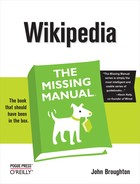
![During 2006 and 2007, about half the articles that were created were subsequently deleted; an unknown number were also essentially deleted by being made into redirects. Between late 2006 and mid-2007, article deletions averaged about 2,000 per day. Since then, the trend has been downward, with the average in late 2007 being about 1,500 articles per day deleted. [This graph is from editor Dragons Flight (Robert A. Rohde), based on a log analysis he did in late 2007.]](http://imgdetail.ebookreading.net/design/5/9780596515164/9780596515164__wikipedia-the-missing__9780596515164__httpatomoreillycomsourceoreillyimages20151.png)
